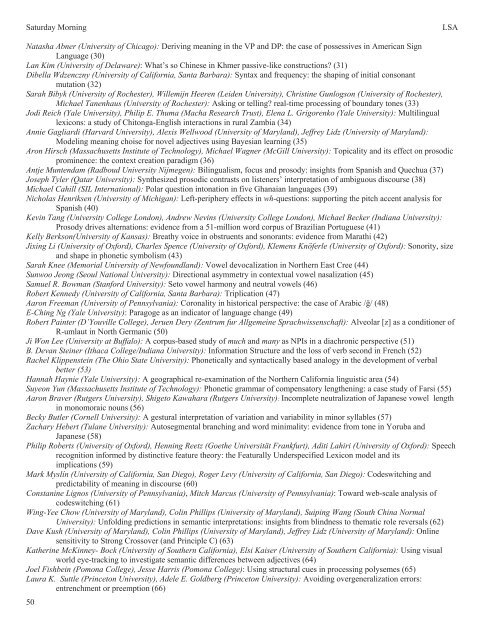here - Linguistic Society of America
here - Linguistic Society of America
here - Linguistic Society of America
Create successful ePaper yourself
Turn your PDF publications into a flip-book with our unique Google optimized e-Paper software.
Saturday MorningLSANatasha Abner (University <strong>of</strong> Chicago): Deriving meaning in the VP and DP: the case <strong>of</strong> possessives in <strong>America</strong>n SignLanguage (30)Lan Kim (University <strong>of</strong> Delaware): What’s so Chinese in Khmer passive-like constructions? (31)Dibella Wdzenczny (University <strong>of</strong> California, Santa Barbara): Syntax and frequency: the shaping <strong>of</strong> initial consonantmutation (32)Sarah Bibyk (University <strong>of</strong> Rochester), Willemijn Heeren (Leiden University), Christine Gunlogson (University <strong>of</strong> Rochester),Michael Tanenhaus (University <strong>of</strong> Rochester): Asking or telling? real-time processing <strong>of</strong> boundary tones (33)Jodi Reich (Yale University), Philip E. Thuma (Macha Research Trust), Elena L. Grigorenko (Yale University): Multilinguallexicons: a study <strong>of</strong> Chitonga-English interactions in rural Zambia (34)Annie Gagliardi (Harvard University), Alexis Wellwood (University <strong>of</strong> Maryland), Jeffrey Lidz (University <strong>of</strong> Maryland):Modeling meaning choise for novel adjectives using Bayesian learning (35)Aron Hirsch (Massachusetts Institute <strong>of</strong> Technology), Michael Wagner (McGill University): Topicality and its effect on prosodicprominence: the context creation paradigm (36)Antje Muntendam (Radboud University Nijmegen): Bilingualism, focus and prosody: insights from Spanish and Quechua (37)Joseph Tyler (Qatar University): Synthesized prosodic contrasts on listeners’ interpretation <strong>of</strong> ambiguous discourse (38)Michael Cahill (SIL International): Polar question intonation in five Ghanaian languages (39)Nicholas Henriksen (University <strong>of</strong> Michigan): Left-periphery effects in wh-questions: supporting the pitch accent analysis forSpanish (40)Kevin Tang (University College London), Andrew Nevins (University College London), Michael Becker (Indiana University):Prosody drives alternations: evidence from a 51-million word corpus <strong>of</strong> Brazilian Portuguese (41)Kelly Berkson(University <strong>of</strong> Kansas): Breathy voice in obstruents and sonorants: evidence from Marathi (42)Jixing Li (University <strong>of</strong> Oxford), Charles Spence (University <strong>of</strong> Oxford), Klemens Knöferle (University <strong>of</strong> Oxford): Sonority, sizeand shape in phonetic symbolism (43)Sarah Knee (Memorial University <strong>of</strong> Newfoundland): Vowel devocalization in Northern East Cree (44)Sunwoo Jeong (Seoul National University): Directional asymmetry in contextual vowel nasalization (45)Samuel R. Bowman (Stanford University): Seto vowel harmony and neutral vowels (46)Robert Kennedy (University <strong>of</strong> California, Santa Barbara): Triplication (47)Aaron Freeman (University <strong>of</strong> Pennsylvania): Coronality in historical perspective: the case <strong>of</strong> Arabic /ğ/ (48)E-Ching Ng (Yale University): Paragoge as an indicator <strong>of</strong> language change (49)Robert Painter (D’Youville College), Jeruen Dery (Zentrum fur Allgemeine Sprachwissenschaft): Alveolar [z] as a conditioner <strong>of</strong>R-umlaut in North Germanic (50)Ji Won Lee (University at Buffalo): A corpus-based study <strong>of</strong> much and many as NPIs in a diachronic perspective (51)B. Devan Steiner (Ithaca College/Indiana University): Information Structure and the loss <strong>of</strong> verb second in French (52)Rachel Klippenstein (The Ohio State University): Phonetically and syntactically based analogy in the development <strong>of</strong> verbalbetter (53)Hannah Haynie (Yale University): A geographical re-examination <strong>of</strong> the Northern California linguistic area (54)Suyeon Yun (Massachusetts Institute <strong>of</strong> Technology): Phonetic grammar <strong>of</strong> compensatory lengthening: a case study <strong>of</strong> Farsi (55)Aaron Braver (Rutgers University), Shigeto Kawahara (Rutgers University): Incomplete neutralization <strong>of</strong> Japanese vowel lengthin monomoraic nouns (56)Becky Butler (Cornell University): A gestural interpretation <strong>of</strong> variation and variability in minor syllables (57)Zachary Hebert (Tulane University): Autosegmental branching and word minimality: evidence from tone in Yoruba andJapanese (58)Philip Roberts (University <strong>of</strong> Oxford), Henning Reetz (Goethe Universität Frankfurt), Aditi Lahiri (University <strong>of</strong> Oxford): Speechrecognition informed by distinctive feature theory: the Featurally Underspecified Lexicon model and itsimplications (59)Mark Myslín (University <strong>of</strong> California, San Diego), Roger Levy (University <strong>of</strong> California, San Diego): Codeswitching andpredictability <strong>of</strong> meaning in discourse (60)Constanine Lignos (University <strong>of</strong> Pennsylvania), Mitch Marcus (University <strong>of</strong> Pennsylvania): Toward web-scale analysis <strong>of</strong>codeswitching (61)Wing-Yee Chow (University <strong>of</strong> Maryland), Colin Phillips (University <strong>of</strong> Maryland), Suiping Wang (South China NormalUniversity): Unfolding predictions in semantic interpretations: insights from blindness to thematic role reversals (62)Dave Kush (University <strong>of</strong> Maryland), Colin Phillips (University <strong>of</strong> Maryland), Jeffrey Lidz (University <strong>of</strong> Maryland): Onlinesensitivity to Strong Crossover (and Principle C) (63)Katherine McKinney- Bock (University <strong>of</strong> Southern California), Elsi Kaiser (University <strong>of</strong> Southern California): Using visualworld eye-tracking to investigate semantic differences between adjectives (64)Joel Fishbein (Pomona College), Jesse Harris (Pomona College): Using structural cues in processing polysemes (65)Laura K. Suttle (Princeton University), Adele E. Goldberg (Princeton University): Avoiding overgeneralization errors:entrenchment or preemption (66)50
















